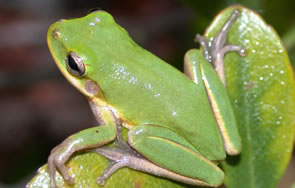
Squirrel Treefrog
Hyla squirella
Photo by JD Willson
Description: The squirrel treefrog is a small, smooth-skinned frog that can change color rapidly, from green to yellowish brown or brown. It generally has a poorly developed yellowish stripe on each side and sometimes spotting on the back.
Habitats and Habits: Squirrel treefrogs occur in a wide variety of habitats, ranging from pine savannas to urban backyards. They are found primarily in the Coastal Plain, although they may be introduced into other parts of the state by hitchhiking on garden materials. Squirrel treefrogs are nocturnal and spend the daylight hours hiding under leaves, bark or logs. Eggs are deposited singly at the bottom of shallow, temporary pools, and tadpoles require at least seven weeks to complete metamorphosis.
Call: Breeding occurs from April to August. Their breeding call is a nasal “waaak, waaak,” repeated about 15 times in 10 seconds. They also have a “rain call,” which is a scolding, squirrel-like rasp usually performed away from water before or during rain storms. Consequently, they are sometimes called “rain frogs.”
Frog Fact: Squirrel treefrogs and other treefrogs are often seen at night around lighted windows and street lights, where they feed on insects.

The shaded region represents the range of the squirrel treefrog in North Carolina.
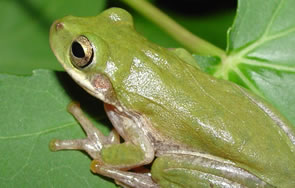
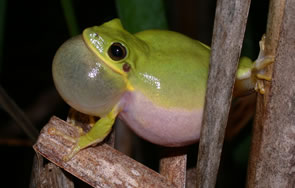
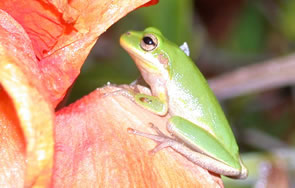
A squirrel treefrog calling.
Photo
by RW Van Devender
Photo by Aubrey M. Heupel
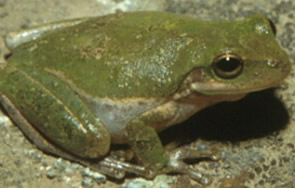
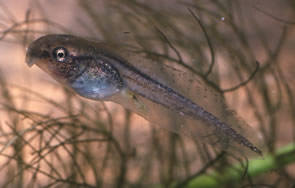
Photo by RW Van Devender
This website created by: Grant Connette and Evan Eskew.
For comments or questions contact M. Dorcas: midorcas@davidson.edu.
M. Dorcas homepage: http://bio.davidson.edu/dorcas
Davidson College, Davidson, North Carolina 28035-1719.
Text and maps from: Dorcas, M. E., S. J. Price, J. C Beane, and S. S. Cross. 2007. The Frogs and Toads of North Carolina. North Carolina Wildlife Resources Commission, Raleigh, NC. – Copyright by Michael E. Dorcas
Partial Funding for this website provided by a Associate Colleges of the South, National Science Foundation, and Duke Energy.
